
DIpil Das
The Coresight Research team attended Pitney Bowes’ 2019 investor day on May 29, 2019, in New York City. The event featured presentations from the company’s CEO, CFO and leaders of its SMB solutions, financial services, software and data services and commerce services business units.
Marc Lautenbach, President and CEO
Lautenbach kicked off his presentation with a discussion of Q1 results, which he termed disappointing; however, the company’s long-term opportunity and strategic outlook remain attractive. He cited several characteristics of a transformation (as opposed to a turnaround), stressing that Pitney Bowes was in transformation. Lautenbach’s presentation focused on the following points:
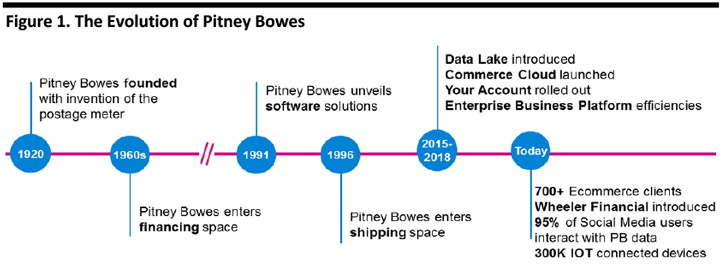 Source: Company reports[/caption]
Key SMB strategic priorities for 2019 include the following:
Source: Company reports[/caption]
Key SMB strategic priorities for 2019 include the following:
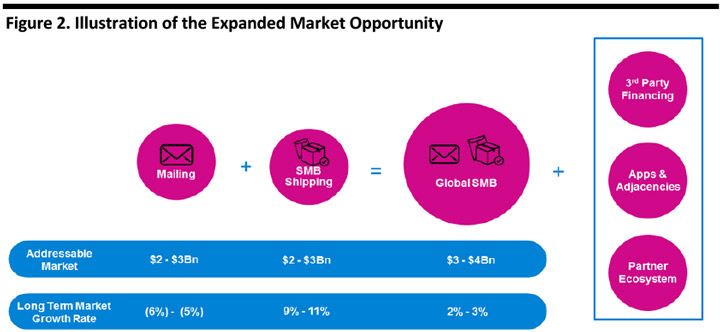 Source: Company reports[/caption]
Christopher Johnson, SVP and President, Financial Services
Johnson’s remarks centered on three key points for financial services.
Source: Company reports[/caption]
Christopher Johnson, SVP and President, Financial Services
Johnson’s remarks centered on three key points for financial services.
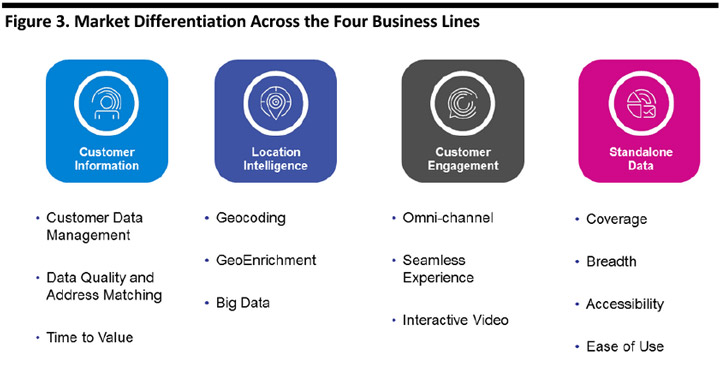 Source: Company reports[/caption]
The business aggregates data in multiple forms, including:
Source: Company reports[/caption]
The business aggregates data in multiple forms, including:
 Source: Company reports[/caption]
In Presort, Pitney Bowes handles 10% of the US Postal Service’s mail and 25% of its first-class mail.
The division participates in attractive markets:
Source: Company reports[/caption]
In Presort, Pitney Bowes handles 10% of the US Postal Service’s mail and 25% of its first-class mail.
The division participates in attractive markets:
 Source: Company reports[/caption]
Snyder discussed making the clients’ brands the hero, i.e., using the client’s branding on shipped products, in contrast to competitors (i.e., shipping companies) who use their own branding on shipping boxes. For example, Pitney Bowes recently released its Consumer Connect app to track the shipment of e-commerce products. Consumers check the status of a shipment an average of eight times between order and delivery.
Pitney Bowes is also working to offer three-day guaranteed delivery, which still is “largely acceptable” for most consumers.
[caption id="attachment_89414" align="aligncenter" width="720"]
Source: Company reports[/caption]
Snyder discussed making the clients’ brands the hero, i.e., using the client’s branding on shipped products, in contrast to competitors (i.e., shipping companies) who use their own branding on shipping boxes. For example, Pitney Bowes recently released its Consumer Connect app to track the shipment of e-commerce products. Consumers check the status of a shipment an average of eight times between order and delivery.
Pitney Bowes is also working to offer three-day guaranteed delivery, which still is “largely acceptable” for most consumers.
[caption id="attachment_89414" align="aligncenter" width="720"]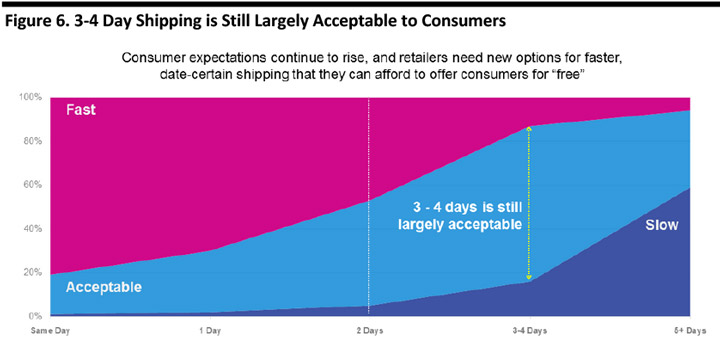 Source: PB Global Ecommerce Study 2018[/caption]
In addition, the company’s shipping API offers many capabilities, with more coming this year.
[caption id="attachment_89415" align="aligncenter" width="720"]
Source: PB Global Ecommerce Study 2018[/caption]
In addition, the company’s shipping API offers many capabilities, with more coming this year.
[caption id="attachment_89415" align="aligncenter" width="720"] Source: Company reports[/caption]
Snyder also commented that significant e-commerce volume originates in international markets, for delivery to US customers. China alone ships 1.6 billion parcels to the US each year, and the UK was also outlined as a key geography.
Finally, she predicted that the Global Ecommerce business will be profitable in 2020 as volumes and scale increase.
Stan Sutula, EVP and CFO
Sutula commented that revenue growth is shifting to higher-growth business (and Pitney Bowes aims to grow faster than its markets).
[caption id="attachment_89416" align="aligncenter" width="720"]
Source: Company reports[/caption]
Snyder also commented that significant e-commerce volume originates in international markets, for delivery to US customers. China alone ships 1.6 billion parcels to the US each year, and the UK was also outlined as a key geography.
Finally, she predicted that the Global Ecommerce business will be profitable in 2020 as volumes and scale increase.
Stan Sutula, EVP and CFO
Sutula commented that revenue growth is shifting to higher-growth business (and Pitney Bowes aims to grow faster than its markets).
[caption id="attachment_89416" align="aligncenter" width="720"]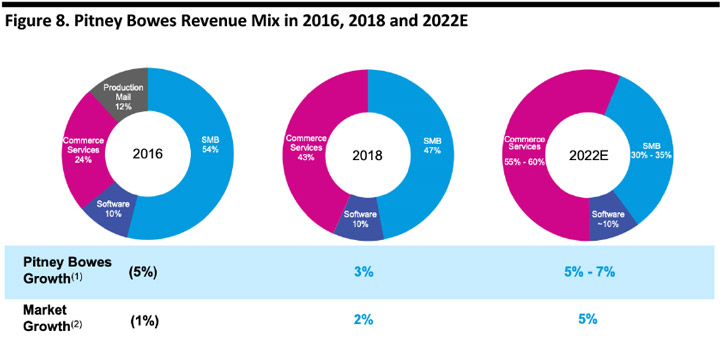 Source: Company reports[/caption]
The figure below summarizes the company’s long-term financial model in 2022.
[caption id="attachment_89417" align="aligncenter" width="720"]
Source: Company reports[/caption]
The figure below summarizes the company’s long-term financial model in 2022.
[caption id="attachment_89417" align="aligncenter" width="720"] Source: Company reports[/caption]
Finally, Sutula summarized his financial remarks as follows:
Source: Company reports[/caption]
Finally, Sutula summarized his financial remarks as follows:
- Management is taking necessary actions to create long-term value.
- Revenue growth is expected improve as the product portfolio continues to shift to growth markets.
- The global e-commerce business is expected to be profitable in 2020.
- Earnings before interest and taxes (EBIT) for the SMB business is expected to be flat or better in 2021.
- Pitney Bowes expects to deliver earnings and free-cash-flow expansion.
- Strategy: reducing the complexity of mailing and shipping, striving for operational excellence and leveraging economies of scale and experience.
- Innovation: Receiving a higher share of new products (20% today vs. 5% in 2012), achieving best-of-breed operational performance in the enterprise business platform, leveraging the company’s commerce cloud to enable new products and services, and the company plans to launch new enterprise products in 2019.
- Culture: Pitney Bowes features a value-driven, high-performance culture, has improved all employee engagement metrics since 2013 and is narrowing the gap with or exceeding metrics of other high-performance companies.
- Clients: Net Promoter Scores (NPS) improved in all business units in 2018, the net satisfaction score for pb.com reached a record high in 2018, more than 750,000 global SMB clients are benefiting from new value-added services and the company has more than 700 global ecommerce clients today vs. only one client and capability in 2012.
- Employees: The company invested $18 million in the annual wages of hourly employees in 2018, now 56% of open jobs are filled by internal candidates, 42% of the global workforce (and 28% of senior executives) are female, and people of color comprise 47% of the company’s workforce.
- Governance and Board: the company has separate CEO and chairman positions, 40% of the board consists of women and the company’s executive compensation program was redesigned to align with performance.
- Community: Dedication to education remains a priority, and the Pitney Bowes Foundation provided 155,000 students with 4.3 million hours of education last year and supported more than 1,800 organizations through matching gifts.
- Financial Stewardship: While the company’s total shareholder return is lagging, Pitney Bowes has reported two consecutive years of revenue growth, reduced operating expense by $400 million, reduced gross inventory by 70%, reduced debt-related obligations by more than $1 billion and returned $1.3 billion to shareholders.
- The company has taken holistic actions to drive long-term value.
- Pitney Bowes is building off its core capabilities to expand into natural adjacencies.
- Revenue growth is an important step for future earnings expansion.
- The company is redefining its opportunity through natural adjacencies.
- SMB’s evolution is happening now.
- SMB has a path to growth and flat or better EBIT in 2021 vs. 2020.
 Source: Company reports[/caption]
Key SMB strategic priorities for 2019 include the following:
Source: Company reports[/caption]
Key SMB strategic priorities for 2019 include the following:
- Simplifying and repositioning the portfolio: Expanding value via a simplified portfolio, centering on making and shipping, featuring an open platform that is Internet of Things (IoT) connected and which reduces complexity and cost.
- Creating new offerings in SMB shipping: Pitney Bowes plans to capitalize on natural adjacencies, leverage economies of scale and experience, develop multi-channel devices and provide new offerings and gain new clients.
- Accelerating the speed of innovation globally: The company recently completed more product launches in countries such as Australia, Canada, France, Germany, India, Japan and the UK, with each launch increasing the speed of innovation and learning, gaining local expertise and resulting in new partnerships.
- Driving new value beyond sending: The Pitney Bowes ecosystem offers financial services, data and analytics, a growing ecosystem of partners, an expending developer community and strengthens activation and consumption capabilities.
 Source: Company reports[/caption]
Christopher Johnson, SVP and President, Financial Services
Johnson’s remarks centered on three key points for financial services.
Source: Company reports[/caption]
Christopher Johnson, SVP and President, Financial Services
Johnson’s remarks centered on three key points for financial services.
- Improved captive finance business: The annual rate of decrease in lease net finance receivables slowed to (3)% in 2017-2018, as compared to (11)% annually during 2013-2016.
- Launched Wheeler Financial from Pitney Bowes: In March 2019, Pitney Bowes launched Wheeler Financial, an FDIC-protected bank, which builds on the company’s long experience in equipment finance to serve the growing, underserved market of providing capital to small businesses. The bank aims to achieve loan volume of $50-70 million in 2019 and provide an accretive return on assets with above-industry performance.
- Enabled growth in commerce services and SMB: Growth in shipping lending has continued for nine consecutive quarters, which enabled more than 85% of volume resulting from of application program interfaces (APIs), totaling more than $165 million of credit extended to customers for shipping.
- Leveraging core Pitney Bowes: The company has decades of name and address expertise, billions of verified addresses and high-quality data.
- Focusing on its strategic portfolio: This includes data monetization, customer information, location intelligence and digital customer management.
- Generating incremental lift with partners: Global and regional system-integrator partners participate in nearly half of new business opportunities.
 Source: Company reports[/caption]
The business aggregates data in multiple forms, including:
Source: Company reports[/caption]
The business aggregates data in multiple forms, including:
- Large-area information.
- Nearby information.
- Property information.
- Customer persona.
- Household / business
- E-mail and social-network handles
- Addressing and enrichment.
- Location intelligence.
- Social enhancement.
 Source: Company reports[/caption]
In Presort, Pitney Bowes handles 10% of the US Postal Service’s mail and 25% of its first-class mail.
The division participates in attractive markets:
Source: Company reports[/caption]
In Presort, Pitney Bowes handles 10% of the US Postal Service’s mail and 25% of its first-class mail.
The division participates in attractive markets:
- Presort services: a $3-4 billion market, growing at 0-2%, with 15+% EBIT margins.
- Global e-commerce: a $40-44 billion market, growing at 12-14%, with 8-12% EBIT margins.
 Source: Company reports[/caption]
Snyder discussed making the clients’ brands the hero, i.e., using the client’s branding on shipped products, in contrast to competitors (i.e., shipping companies) who use their own branding on shipping boxes. For example, Pitney Bowes recently released its Consumer Connect app to track the shipment of e-commerce products. Consumers check the status of a shipment an average of eight times between order and delivery.
Pitney Bowes is also working to offer three-day guaranteed delivery, which still is “largely acceptable” for most consumers.
[caption id="attachment_89414" align="aligncenter" width="720"]
Source: Company reports[/caption]
Snyder discussed making the clients’ brands the hero, i.e., using the client’s branding on shipped products, in contrast to competitors (i.e., shipping companies) who use their own branding on shipping boxes. For example, Pitney Bowes recently released its Consumer Connect app to track the shipment of e-commerce products. Consumers check the status of a shipment an average of eight times between order and delivery.
Pitney Bowes is also working to offer three-day guaranteed delivery, which still is “largely acceptable” for most consumers.
[caption id="attachment_89414" align="aligncenter" width="720"] Source: PB Global Ecommerce Study 2018[/caption]
In addition, the company’s shipping API offers many capabilities, with more coming this year.
[caption id="attachment_89415" align="aligncenter" width="720"]
Source: PB Global Ecommerce Study 2018[/caption]
In addition, the company’s shipping API offers many capabilities, with more coming this year.
[caption id="attachment_89415" align="aligncenter" width="720"] Source: Company reports[/caption]
Snyder also commented that significant e-commerce volume originates in international markets, for delivery to US customers. China alone ships 1.6 billion parcels to the US each year, and the UK was also outlined as a key geography.
Finally, she predicted that the Global Ecommerce business will be profitable in 2020 as volumes and scale increase.
Stan Sutula, EVP and CFO
Sutula commented that revenue growth is shifting to higher-growth business (and Pitney Bowes aims to grow faster than its markets).
[caption id="attachment_89416" align="aligncenter" width="720"]
Source: Company reports[/caption]
Snyder also commented that significant e-commerce volume originates in international markets, for delivery to US customers. China alone ships 1.6 billion parcels to the US each year, and the UK was also outlined as a key geography.
Finally, she predicted that the Global Ecommerce business will be profitable in 2020 as volumes and scale increase.
Stan Sutula, EVP and CFO
Sutula commented that revenue growth is shifting to higher-growth business (and Pitney Bowes aims to grow faster than its markets).
[caption id="attachment_89416" align="aligncenter" width="720"] Source: Company reports[/caption]
The figure below summarizes the company’s long-term financial model in 2022.
[caption id="attachment_89417" align="aligncenter" width="720"]
Source: Company reports[/caption]
The figure below summarizes the company’s long-term financial model in 2022.
[caption id="attachment_89417" align="aligncenter" width="720"] Source: Company reports[/caption]
Finally, Sutula summarized his financial remarks as follows:
Source: Company reports[/caption]
Finally, Sutula summarized his financial remarks as follows:
- Portfolio evolution is expected to deliver sustainable revenue growth.
- The portfolio is balanced in terms of providing growth and improved profitability.
- Management will continue to drive operational excellence.
- A balanced investment should deliver growth and competitive shareholder return.
- The company is maintaining the strategic flexibility to drive its valuation.